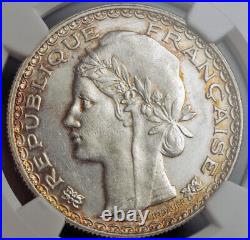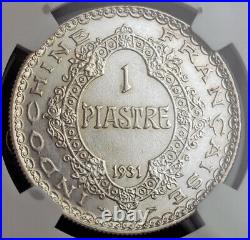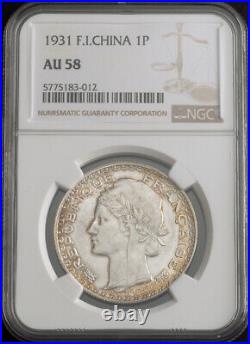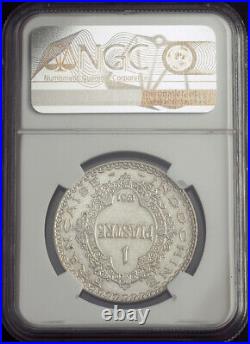




Silver Piastre (Colonial Trade Dollar) Coin. Mint Year: 1931 Reference: KM-19. Mint Mark: A (Paris Mint) Denomination: Piastre (Colonial Trade Coin) Condition. Certified and graded by NGC as AU-58! Diameter: 35mm Material: Silver Weight: 20gm. Obverse: Female caped and wreathed bust (personification of France) left. Legend: REPUBLIQUE FRANCAISE Exergue: BARRE / 1924. Reverse: Value (1) above denomination (PIASTRE) and date (1931). All within decorative border. Privy marks (cornucopia / wing) of the Paris mint below. Legend: INDOCHINE FRANCAISE (cornucopia / wing). The piastre de commerce was the currency of French Indochina between 1885 and 1952. It was subdivided into 100. Prior to the arrival of the French in Indo-China in the second half of the 19th century, cash coins similar to those used in the provinces of China circulated in the area that is nowadays known as Vietnam. There was also a silver milled dragon coin and associated subsidiary coinage in circulation. The dragon coin is believed to have been in imitation of the Spanish and Mexican silver dollars which also circulated widely in the region at that time, however the dragon dollars were worth less because the fineness of the silver was less than that in the Spanish and Mexican dollars. In the region that is nowadays Cambodia and Laos, the Siamese coinage circulated and Cambodia had its own regional varieties of the Siamese Tical (Thai Baht). The French began their Indo-Chinese empire in 1862 with Cochin-China which is the area around the Mekong delta and Saigon, and which is nowadays the extreme southern part of Vietnam. This empire very quickly expanded to include Cambodia which had been a vassal state of the Kingdom of Siam. In 1875, the French introduced a Cambodian franc to Cambodia. Although these francs were minted in Belgium between 1875 and 1885, they always bore the date 1860. The French also began to introduce a subsidiary coinage in’cents’ into Cochin-China in the late 1870s. These cents were actually subsidiary coinage of the Mexican dollar unit as opposed to being subsidiary coinage of the French franc. In 1884, the French Indo-Chinese empire further expanded to incorporate Annam and Tonkin-China. The following year, in 1885, the French introduced a new silver Piastre de commerce and associated subsidiary coinage throughout the entire Indo-Chinese colonies in order to increase monetary stability. The piastre was initially equivalent to the Mexican peso. The piastre was therefore a direct lineal descendent of the Spanish pieces of eight that had been brought to the orient from Mexico on the Manila Galleons. It was initially on a silver standard of 1 piastre = 24.4935 grams pure silver. This was reduced to 24.3 grams in 1895. French Indo-China was one of the last places to abandon the silver standard. The silver standard was restored in 1921 and maintained until 1930, when the piastre was pegged to the franc at a rate of 1 piastre = 10 francs. However, in December 1945, to avoid the French francs devaluation, the peg was changed to 1 piastre = 17 francs. Was the part of the French colonial empire in Indochina in southeast Asia. A federation of the three Vietnamese regions, Tonkin, Annam, and Cochinchina, as well as Cambodia, was formed in 1887. Laos was added in 1893. The capital was moved from Saigon to Hanoi in 1902. During World War II, the colony was administered by Vichy France and was under Japanese occupation. Beginning in 1945, Ho Chi Minh led a communist revolt against French rule known as the French Indochina War. In the South, an anti-Communist government led by former Emperor Bao Dai was granted independence in 1949. Following the Geneva Accord of 1954, Ho’s group became the government of North Vietnam, although the Bao Dai government continued to rule in the South. The colonial administration of Annam, or Central Vietnam, was dissolved in 1955 and region was split between North and South, as provided for in the Geneva Accord. The item “1931, French Indo-China. Silver Piastre (Colonial Trade Dollar) Coin. NGC AU-58″ is in sale since Sunday, June 21, 2020. This item is in the category “Coins & Paper Money\Coins\ World\Asia\Other Asian Coins”. The seller is “coinworldtv” and is located in Wien. This item can be shipped worldwide.
- Country/Region of Manufacture: France
- Certification: NGC
- Grade: AU 58
- Year: 1931
- Composition: Silver
- KM Number: 19
